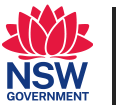Chainsaw Operations
Technical
Scope
This Operational Guideline covers is to be followed when using chainsaws. This includes all activities such as; tree felling, limbing, pruning, and skirting.
Fundamental Protocols underpin the actions of all NSW Rural Fire Service (RFS) members and must be adhered to at all times. They outline the Principles of being an RFS member and provide guidance on conduct to support the safety and wellbeing of members.
Guiding Principles
- The RFS prescribes three levels of chainsaw activities:
- Trim and Cut Felled Trees (TFT) – the clearing or moving of fallen timber and trees.
- Tree Felling Intermediate (TFI) – the felling of trees where the tree is not on a fire line and not defective or affected by fire.
- Tree Falling Fireline (Advanced) (TFF) – the felling of trees on a fire line or where the tree is defective.
- All chainsaw activities will consider the RFS OPG - Hazardous Trees.
Operations
- Prior to operation, the operator shall:
- Be qualified and have RFS current competency in the relevant activity to be undertaken.
- Wear the appropriate personal protective clothing and equipment (PPC/PPE) correctly, including helmet, eye protection, hearing protection, boots, and chainsaw chaps/trousers.
- Have appropriate chainsaw and support tools present for the operation.
- Undertake refuelling and fuel mixing in an appropriate area which is well ventilated (e.g., not indoors and greater than 3 metres from ignition sources).
- Undertake a risk assessment that may be written (for planned events) or form part of the Dynamic Risk Assessment (DRA) (for incidents).
- If undertaking TFT operations, have an assistant/offsider with Bush Firefighter (BF) qualifications.
- If undertaking TFI or TFF operations, have an assistant/offsider with TFI qualifications.
- If a qualified offsider is not present, a BF may be used with the approval of the duty officer/Incident Controller (IC).
- As a pre-works check, the operator shall ensure:
- Chainsaw pre-start checks are done in accordance with manufacturer’s instruction.
- The chain brake is engaged before starting the chainsaw, this will also check that the chain brake is operational.
- Whilst operating the chainsaw, the operator shall ensure:
- All cutting is undertaken in accordance with relevant environmental approvals for planned events, or for incidents in accordance with the IC’s intent or Incident Action Plan (IAP).
- A minimum of 3 metres distance is maintained between the chainsaw and other workers/bystanders at all times. For TFI and TFF operations, a minimum distance of twice the height of the tallest tree should be observed.
Special Considerations
- The use of a chainsaw is at the discretion of the chainsaw operator and no other person shall direct them to undertake any operation if the operator feels it is unsafe to do so.
- Tree felling and chainsaw use after dark is not recommended and should only be considered in exceptional circumstances. In such instances, sufficient lighting to illuminate the entire work area (including areas where logs/trees will move to when cuts are made) and tree canopy must be provided.
- The felling of hung up trees shall not be conducted without the use of machinery or mechanical assistance.
- If any issues have been identified and cannot be rectified during the pre-start check:
- advise the Officer in Charge (OIC) immediately;
- tag the equipment for repair; and
- complete Report Defect – Equipment in Enterprise Asset Management (EAM) or follow local reporting procedures.
- Tagged equipment must not be used until the defect is resolved and tag removed by a qualified person.
- Only qualified personnel are permitted to complete maintenance on the chainsaw.
- When using battery powered or electric chainsaws, the power source must be removed/locked out prior to any maintenance.
- For non-incident operations, for example, when cutting close to waterways, personnel must adhere to the Bush Fire Environmental Assessment Code or appropriate environmental approval.
- Green waste from AIDER/mitigation works are to be either chipped/mulched back into the work area, taken to a waste transfer station, or left onsite in accordance with the appropriate environmental approvals.
- The property owner(s) is responsible for green waste from storm damage make safe chainsaw operations carried out by RFS personnel. The green waste should be stacked neatly in accordance with a work order or as per landholder agreement. Logs need to be cut into safe manageable sections. Permission is required from the owner to remove any waste from their land.
Related Information
Content Owner:
Area Operations
Date Approved:
26 Sep 2023
Review Required:
26 Sep 2026
Version:
1.0
If you have any questions or feedback on Operational Doctrine, please email Ops.Performance@rfs.nsw.gov.au.



